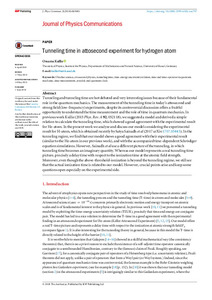| dc.date.accessioned | 2018-08-21T07:08:02Z | |
| dc.date.available | 2018-08-21T07:08:02Z | |
| dc.date.issued | 2018-06-01 | |
| dc.identifier.issn | 2399-6528 | |
| dc.identifier.uri | urn:nbn:de:hebis:34-2018082156243 | |
| dc.identifier.uri | http://hdl.handle.net/123456789/2018082156243 | |
| dc.description.sponsorship | Gefördert durch den Publikationsfonds der Universität Kassel | |
| dc.language.iso | eng | |
| dc.rights | Urheberrechtlich geschützt | |
| dc.rights.uri | https://rightsstatements.org/page/InC/1.0/ | |
| dc.subject | ultrafast science | eng |
| dc.subject | attosecond physics | eng |
| dc.subject | tunneling time | eng |
| dc.subject | time-energy uncertainty relation | eng |
| dc.subject | time and time-operator in quantum mechanic | eng |
| dc.subject | time measurement | eng |
| dc.subject | attoclok and quantum clock | eng |
| dc.subject.ddc | 530 | |
| dc.title | Tunneling time in attosecond experiment for hydrogen atom | eng |
| dc.type | Aufsatz | |
| dcterms.abstract | Tunneling and tunneling time are hot debated and very interesting issues because of their fundamental role in the quantum mechanics. The measurement of the tunneling time in today's attosecond and strong field (low-frequency) experiments, despite its controversial discussion offers a fruitful opportunity to understand the time measurement and the role of time in quantum mechanics. In previous work Kullie (2015 Phys. Rev. A 92, 052118), we suggested a model and derived a simple relation to calculate the tunneling time, which showed a good agreement with the experimental result for He-atom. In the present work we analyze and discuss our model considering the experimental result for H-atom, which is obtained recently by Satya Sainadh et al (2017 arXiv:1707.05445). In the tunneling region, we find that our model shows a good agreement with their experimental result (similar to the He-atom in our previous work), and with the accompanied time-dependent Schrödiger equation simulations. However, Sainadh et al use a different picture of the tunneling, in which tunneling time becomes an imaginary quantity. Whereas our model represents a real tunneling time picture, precisely a delay time with respect to the ionization time at the atomic field strength. Moreover, even though the above-threshold-ionization is beyond the tunneling regime, we still see that the actual ionization time is related to our model. However, crucial points arise and keep some questions open especially on the experimental side. | eng |
| dcterms.accessRights | open access | |
| dcterms.bibliographicCitation | In: Journal of physics communications. - Bristol ; Philadelphia, PA : IOP Publishing Ltd. - 2(2018)065001 | |
| dcterms.creator | Kullie, Ossama | |
| dc.relation.doi | doi:10.1088/2399-6528/aac797 | |

